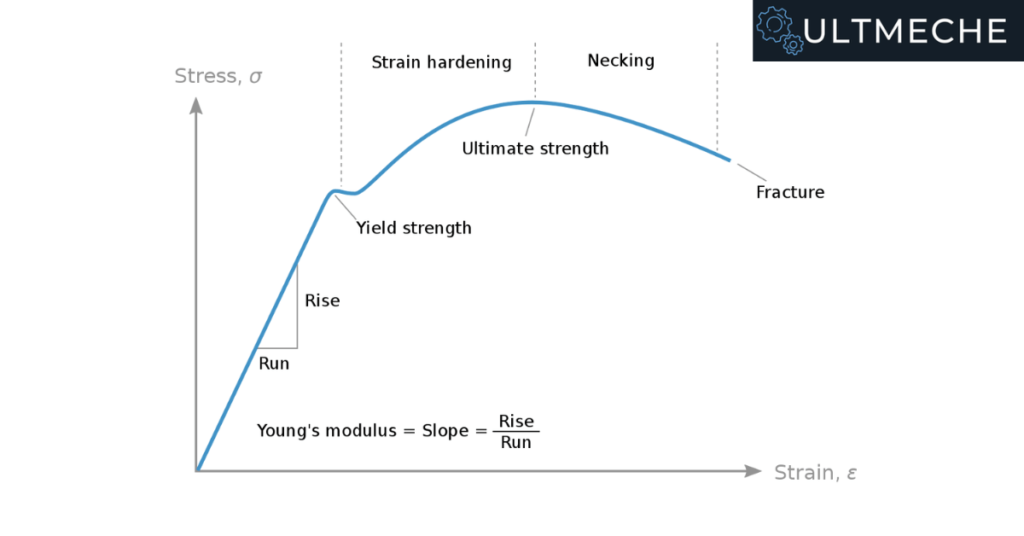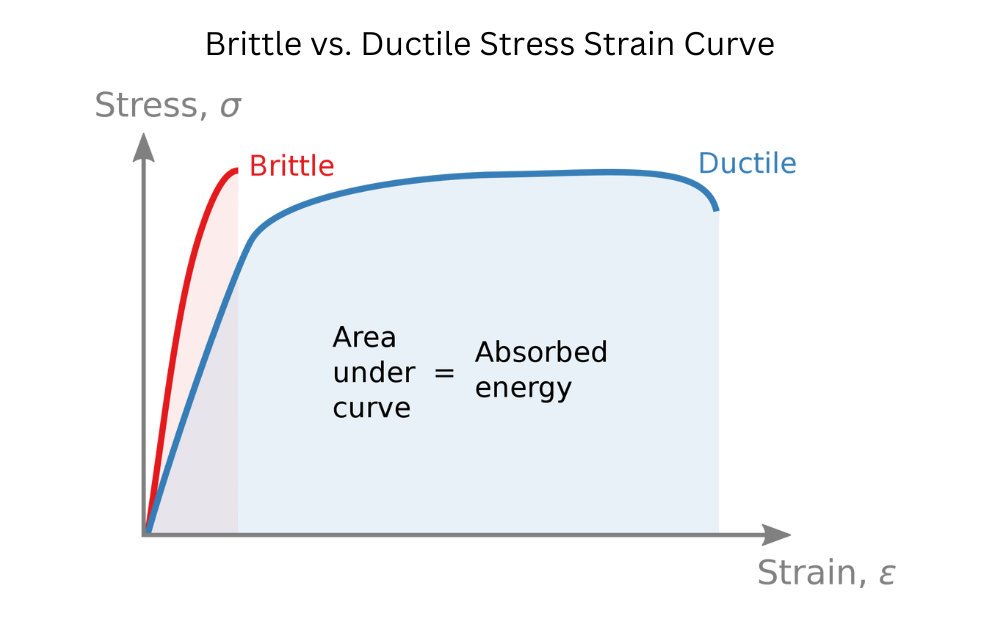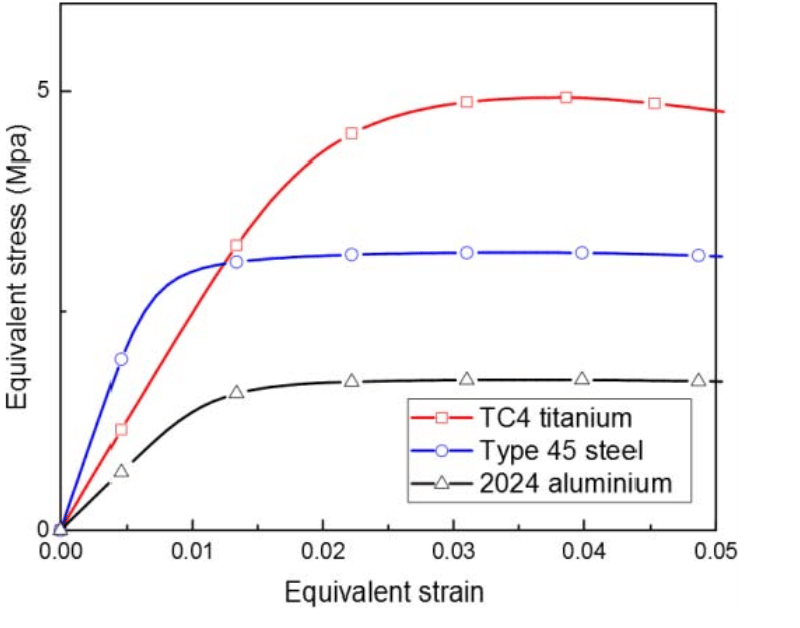A Stress Strain Curve of a material represents the physical values of stress and strain from material testing.
The stress strain curve of a material gives us key data in which we use to determine if the material we are selecting will work.
To get a real stress strain curve of a material specimen, we perform tests such as tensile testing.
December 26, 2024What is a Stress Strain Curve

A Stress Strain Curve of a material represents the physical values of stress and strain from material testing.
Stress
Stress, also denoted as σ, represents a physical quantity of a force over a unit area. In the tensile testing case, this represents the tensile force over the cross sectional area of the diameter of the rod that is being tested.
Check out: What is Stress in Engineering?
Strain
Strain, which is denoted by ε, represents the displacement of the material over the total length of the rod. It is a dimensionless parameter that we use to characterize the mechanical behavior of a material.
Check out: What is Strain in Engineering?
Why is a Stress Strain Curve so important in engineering?
A stress strain curve will tell us whether or not the material will work. As a result, we use these curves to verify mechanical systems so that they can operate safely.
Failure of a mechanical system would be costly and detrimental, so as a result, we need to make sure the system is strong enough.
Stress Strain Curve Points
The following are going to be the key points to look at regarding a strain stress curve. It is important that you understand what each of the points of a stress strain curve represent.
Yield Strength
Yield Strength represents the point in which a material stops linearly deforming and starts plastically deforming.
If we look at the stress strain curve above, we see that up until yield strength, the relationship between stress and strain is linear.
After the yield strength, we start seeing a non-linear (plastic) deformation.
Also, after the part stress exceeds yield strength, it is becoming closer to failure.
Young’s Modulus
Young’s modulus represents the relationship between Stress and Strain.
Mathematically speaking, Young’s modulus represents the slope of the curve.
Values such as Young’s modulus are fixed for materials through many sets of empirical testing.
Ultimate Tensile Strength
Ultimate Tensile Strength represents the highest stress value a material will see before failure.
Values such as Yield Strength and Ultimate Tensile Strength are fixed for materials through many sets of tests.
Strain Hardening
Strain hardening represents the deformation a material experiences after yield strength, as represented in the figure above.
It is common in the industry to “strain harden” components such as bolts to get the desired material strength and hardness we want for our systems. This will ensure that we have adequate margins of safety for specific bolting applications.
Necking
Necking represents the deformation a material experiences after ultimate tensile strength, as represented in the figure above.
After a material experiences it’s ultimate tensile strength, the stress on that material will be going down as it approaches failure.
Fracture
Fracture represents the point in which failure occurs in the stress and strain curve.
In the physical world, this is where the material will break.
This failure will make a very loud noise in the lab during tensile testing.
Allowable Stresses
As a result of many iterations of material specimen tensile testing, we have important values such as:
- Yield Strength
- Ultimate Tensile Strength
- Young’s Modulus
Through the interpretation of many standards in engineering, we then determine what the allowable stresses in our system is.
When we determine design criteria such as allowable stresses and safety factor, we verify the integrity of our mechanical design.
Non Detrimental Deformation
Non detrimental deformation represents deformation in which a part can still return back to initial form, without permanent deformation.
After a part begins to yield, the mechanical behavior of a part will change.
When designing components, it is important to ensure that the appropriate considerations have been taken and that mechanical behavior is understood for product integrity.
Brittle vs. Ductile

The characteristics of a material being brittle or ductile represent their mechanical behavior.
In short, brittle materials have a low strain to failure and ductile materials have high strain to failure.
In physical terms, will the part elongate much more before failure or not at all before failure?
This is what it means by when a material is classified as either brittle or ductile.
Different failure criterion will be used to determine what allowable stresses are depending on material properties such as brittle or ductile.
Notice that the brittle material will fail almost instantly after yielding, whereas the ductile material will experience higher strain to failure.
Stress Strain Curve For Different Materials
Below represents typical mechanical behavior for the following materials:
- Steel
- Aluminum
- Titanium

Aluminum
There’s no doubt that aluminum will exhibit much more lower stresses than steel or aluminum during tensile testing.
Aluminum is a material greatly know for it’s high strength to weight ratio, which makes it very versatile for mechanical applications.
Steel
Steel represents the “medium” point in terms of comparing it between aluminum and titanium.
Typical Type 45 Steel, based on the figure above, will represent ductile behavior, as we can see a high strain after the part begins yielding.
Titanium
From a stress-strain standpoint, titanium is shown to have the highest stresses overall compared to steel or aluminum.
Titanium is a very expensive material compared to aluminum and steel, but is required for high performance applications in various industries.
Closing Thoughts
Overall, it is very important to take many different factors regarding material design and selection.
The stress strain curves of each material give a high level overview of expected mechanical behaviors of parts.
It is important for mechanical design that you determine the right materials and take into account the right failure criterion to ensure parts meet their respective operating conditions.
In some extreme cases, material coupon testing will be required and stress-strain curves will be given to the customer.
The customer will then review this data and see whether or not it fits the needs for their mechanical design.
Are you an engineer and in need of a resume review? Check out: Mechanical Engineering Resume Review
About the author

Kazuyoshi Fujimoto, PE
Founder | Engineering Career Coach | Principal Mechanical Engineer
Kazu oversees all of ultmeche’s engineering services. He provides consulting such as resume reviews, rewrites, mock interviews, and all services career related. Additionally, Kazu performs consulting work regarding Oil & Gas, Automotive, and Aerospace & Defense. Kazu is licensed as a professional engineer in the state of California and has 9+ years of experience in Oil & Gas, Automotive, and Aerospace & Defense.
